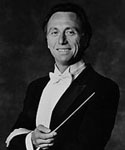Ronald Feldman and the Berkshire Symphony Play Mozart, Hummel, Vivaldi, and Haydn
Haydn Rules in Williamstown, or almost...
By: Michael Miller - Oct 28, 2006
Berkshire SymphonyFriday October 27 2006, 8:00 PM
Chapin Hall
Ronald Feldman, conductor
Mozart: Serenata Notturna
Hummel: Trumpet Concerto with Ethan Bensdorf, (Armando Ghitalla Trumpet Competition winner)
Vivaldi: Double Trumpet Concerto (Rolf Smedvig and Ethan
Bensdorf)
Haydn: Symphony No. 99 in E-flat Major
In his one hundred four symphonies Josef Haydn worked miracles, one after another. I cannot think of one of them which doesn't contain some brilliant surprise: a progression, a rhythm, counterpoint, or an unexpected sonority or application of an instrument, which makes the symphonic form (then, of course, at a fairly early stage of development) seem renewed. This is music for the connoisseur at its best, however much the composer's geniality, tunefulness, and varied repertory of mood make these works accessible to anyone who is willing to listen. These qualities are available in even a mediocre performance, but further treasures continue to appear, as the conductor and his musicians delve deeper into the score, and the greater their musicianship and discipline as an ensemble.
Haydn's music always remains fresh and contemporary. Every generation that approaches his music finds something vital with which they can identify at the deepest level. The modernist generation which emerged between the world wars and continued to influence the music world into the 1960's identified especially strongly with his inventiveness, intellectuality, and sensitive ear and produced several great interpreters of the symphonies, among them Scherchen, Ansermet, and Klemperer, all of them leaders in the performance of contemporary music. (One of the finest Haydn conductors today is a composer, James Bolle, who offers Haydn symphonies almost every summer at his Monadnock Festival.) I once heard a story which especially delights me about Scherchen, in which he horrified an American orchestra manager by demanding fifteen rehearsals for a program of Haydn symphonies. It is instructive that this great conductor, author of the standard "Handbook of Conducting," thought that the works demanded such perfection of ensemble and sonority.
The major work on the Berkshire Symphony's program was one of the twelve great symphonies Haydn wrote late in his career for a series of concerts in London. It was preceded by Mozart's Serenata Notturna, and two familiar concertos for trumpet, Johann Nepomuk Hummel's (Pressburg 1778 - Weimar 1838) concerto for a single trumpet and Antonio Vivaldi's concerto for two trumpets in C Major. The Vivaldi, a radio favorite, is especially familiar, and the slow movement at least of the Hummel has wormed its way into the Musak repertory. None of these works are ever less than enjoyable, and under Ronald Feldman's direction their energetic, full-bodied playing did justice to the music. I've heard more refinement in the Mozart and cleaner ensemble in the Vivaldi, but these performances were pleasing enough on their own terms. Mr. Feldman's direct approach is especially appealing, as are his delight in strong rhythms and meaty ensemble.
One reason for programming the trumpet concertos was to present the winner of the Armando Ghitalla Trumpet Competition, Ethan Bensdorf, who played the Hummel, as well as the second trumpet part in the Vivaldi to Rolf Smedivig's first. There is no doubt that Mr. Bensdorf does everything right. His basic tone is solid and attractive, and he is agile in passage work and sings in extended melodic lines. In the Hummel, after a spirited first movement, I felt he had really come into his own in the slow movement with his singing line and beautifully nuanced coloring, only to be delighted by his lithe, bright playing of the virtuosic finale. Bensdorf played some trills and other ornaments with especially sensitive articulation, almost suggesting a return to bygone days when musicians considered it de rigeur to play ornaments with refinement—the musical equivalent of dressing for dinner. However, he addressed some other ornaments in a more perfunctory fashion.
In Haydn's Symphony No. 99 in E flat Major, Mr. Feldman's affection for the piece is clear enough. His slow introduction to the first movement was broad in tempo and rich in dynamics. In the quick sonata form which follows, Mr. Feldman brought across the hearty good humor of the music and some of the finer details of the writing. Still, a good many nuances of phrasing and dynamics were lost in the somewhat muddy acoustics of Chapin Hall, not to mention the less than immaculate ensemble. It may also be that he felt that some refinements simply led his ensemble of first-rate professionals (mostly Williams faculty) and students too far out onto thin ice. In Haydn's lovely slow movement some moments worked better than others. In places Haydn's sense of drama came across, but in others the transitions seemed merely episodic. At other movements, it seemed as if the orchestra were sight-reading. In the last two movements Mr. Feldman clove to fairly broad tempi, which in the minuet, made the syncopations and varied accents seem rather heavy. He may have sacrificed rehearsal time in the two middle movements in favor of the final vivace, which showed cleaner ensemble and articulation of detail. Even so, the execution was still not on the highest level. All this carping notwithstanding, I thoroughly enjoyed Mr. Feldman's straightforward approach to Haydn's great symphony, and for a college orchestra the Berkshire Symphony is quite impressive.
Sitting at the back of the right side of the balcony, I thought this the most satisfactory sound I have heard in the problematic acoustics of Chapin Hall. Crammed into their elegant Georgian cubicle, the Berkshire Symphony, in spite of its chamber orchestra proportions, could not overcome the sonic murk. However, Mr. Feldman was able to get them to produce a sound which was well-balanced and attractive overall. The Vivaldi came across most effectively, since we are used to hearing his music played in cavernous acoustics, recalling the Church of San Marco.
http://www.homepages.nyu.edu/~mjm11/index.html
michaeljames48@gmail.com




